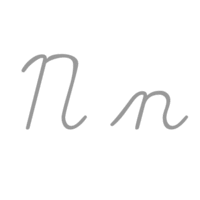N
N or n is the fourteenth letter in the modern English alphabet and the ISO basic Latin alphabet. Its name in English is en (pronounced /ˈɛn/), plural ens.[1]
| N | |
|---|---|
| N n | |
| (See below) | |
 | |
| Usage | |
| Writing system | Latin script |
| Type | Alphabetic and Logographic |
| Language of origin | Latin language |
| Phonetic usage | [n] [ŋ] [ɲ] [ɳ] [nˠ] [ⁿ] [◌̃] /ɛn/ |
| Unicode value | U+004E, U+006E |
| Alphabetical position | 14 |
| History | |
| Development | |
| Time period | ~-700 to present |
| Descendants | • ₦ • Ƞ • Ŋ • ɧ • ʩ |
| Sisters | Н Ң Ӊ Ӈ Ԋ נ ן ن ܢ ނ Ն ն Մ մ ࠍ ነ ᚾ Ꮋ Ꮑ Ꮓ |
| Variations | (See below) |
| Other | |
| Other letters commonly used with | n(x), nh, ng, ny |
|
History
| Egyptian hieroglyph |
Phoenician Nun |
Etruscan N |
Greek Nu | ||
|---|---|---|---|---|---|
One of the most common hieroglyphs, snake, was used in Egyptian writing to stand for a sound like the English ⟨J⟩, because the Egyptian word for "snake" was djet. It is speculated by many that Semitic people working in Egypt adapted hieroglyphics to create the first alphabet, and that they used the same snake symbol to represent N, because their word for "snake" may have begun with that sound. However, the name for the letter in the Phoenician, Hebrew, Aramaic and Arabic alphabets is nun, which means "fish" in some of these languages. The sound value of the letter was /n/—as in Greek, Etruscan, Latin and modern languages.
Use in writing systems
⟨n⟩ represents a dental or alveolar nasal in virtually all languages that use the Latin alphabet, and in the International Phonetic Alphabet. A common digraph with ⟨n⟩ is ⟨ng⟩, which represents a velar nasal in a variety of languages, usually positioned word-finally in English.[2][3] Often, before a velar plosive (as in ink or jungle), ⟨n⟩ alone represents a velar nasal. In Italian and French, ⟨gn⟩ represents a palatal nasal /ɲ/. The Portuguese and Vietnamese spelling for this sound is ⟨nh⟩, while Spanish, Breton, and a few other languages use the letter ⟨ñ⟩.
In English, ⟨n⟩ is generally silent when it is preceded by an ⟨m⟩ at the end of words, as in hymn; however, it is pronounced in this combination when occurring word medially, as in hymnal.
On the other hand, other consonants are often silent when they precede an ⟨n⟩ at the beginning of an English word. Examples include gnome, knife, mnemonic, and pneumonia.
⟨n⟩ is the sixth most common letter and the second-most commonly used consonant in the English language (after ⟨t⟩).[4]
Other uses
In mathematics, the italic form n is a particularly common symbol for a variable quantity which represents a natural number. The set of natural numbers is referred to as ℕ.
Related characters
Descendants and related characters in the Latin alphabet
- N with diacritics: Ń ń Ñ ñ Ň ň Ǹ ǹ Ṅ ṅ Ṇ ṇ Ņ ņ Ṉ ṉ Ṋ ṋ Ꞥ ꞥ ᵰ[5] ᶇ[6]
- Phonetic alphabet symbols related to N (the International Phonetic Alphabet only uses lowercase, but uppercase forms are used in some other writing systems):
- Ŋ ŋ : Latin letter eng, which represents a velar nasal in the IPA
- Ɲ ɲ : Latin letter Ɲ, which represents a palatal nasal or an alveolo-palatal nasal in the IPA
- ⁿ : Superscript small n, which represents a nasal release in the IPA
- Ƞ ƞ : Latin letter Ƞ (encoded in Unicode as "N with long right leg"), a mostly obsolete letter used to transcribe various nasal sounds
- ɳ : Latin letter n with a hook, which represents a retroflex nasal in the IPA
- ᶯ : Modifier letter small n with retroflex hook[7]
- ᶮ : Modifier letter small n with left hook[6]
- ɴ : Small capital N, which represents a uvular nasal in the IPA
- ᶰ : Modifier letter small capital N[6]
- Uralic Phonetic Alphabet-specific symbols related to N:[8]
- U+1D0E ᴎ LATIN LETTER SMALL CAPITAL REVERSED N
- U+1D3A ᴺ MODIFIER LETTER CAPITAL N
- U+1D3B ᴻ MODIFIER LETTER CAPITAL REVERSED N
- U+1D51 ᵑ MODIFIER LETTER SMALL ENG
- ₙ : Subscript small n was used in the Uralic Phonetic Alphabet prior to its formal standardization in 1902[9]
- Teuthonista phonetic transcription system uses U+AB3B ꬻ LATIN SMALL LETTER N WITH CROSSED-TAIL and U+AB3C ꬼ LATIN SMALL LETTER ENG WITH CROSSED-TAIL[3]
- ȵ : N with curl is used in Sino-Tibetanist linguistics[2]
- Ꞑ ꞑ : N with descender
Ancestors and siblings in other alphabets
Derived signs, symbols and abbreviations
- ₦ : Nigerian Naira
Computing codes
| Preview | N | n | ||
|---|---|---|---|---|
| Unicode name | LATIN CAPITAL LETTER N | LATIN SMALL LETTER N | ||
| Encodings | decimal | hex | decimal | hex |
| Unicode | 78 | U+004E | 110 | U+006E |
| UTF-8 | 78 | 4E | 110 | 6E |
| Numeric character reference | N | N | n | n |
| EBCDIC family | 213 | D5 | 149 | 95 |
| ASCII 1 | 78 | 4E | 110 | 6E |
- 1 Also for encodings based on ASCII, including the DOS, Windows, ISO-8859 and Macintosh families of encodings.
Other representations
| NATO phonetic | Morse code |
| November |
 |
|
 |
 |
| Signal flag | Flag semaphore | American manual alphabet (ASL fingerspelling) | Braille dots-1345 Unified English Braille |
References
- "N" Oxford English Dictionary, 2nd edition (1989); Merriam-Webster's Third New International Dictionary of the English Language, Unabridged (1993); "en," op. cit.
- Cook, Richard; Everson, Michael (2001-09-20). "L2/01-347: Proposal to add six phonetic characters to the UCS" (PDF).
- Everson, Michael; Dicklberger, Alois; Pentzlin, Karl; Wandl-Vogt, Eveline (2011-06-02). "L2/11-202: Revised proposal to encode "Teuthonista" phonetic characters in the UCS" (PDF).
- English Letter Frequency
- Constable, Peter (2003-09-30). "L2/03-174R2: Proposal to Encode Phonetic Symbols with Middle Tilde in the UCS" (PDF).
- Constable, Peter (2004-04-19). "L2/04-132 Proposal to add additional phonetic characters to the UCS" (PDF).
- Constable, Peter (2004-04-19). "L2/04-132 Proposal to add additional phonetic characters to the UCS" (PDF).
- Everson, Michael; et al. (2002-03-20). "L2/02-141: Uralic Phonetic Alphabet characters for the UCS" (PDF).
- Ruppel, Klaas; Aalto, Tero; Everson, Michael (2009-01-27). "L2/09-028: Proposal to encode additional characters for the Uralic Phonetic Alphabet" (PDF).
